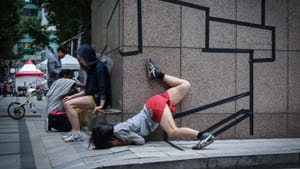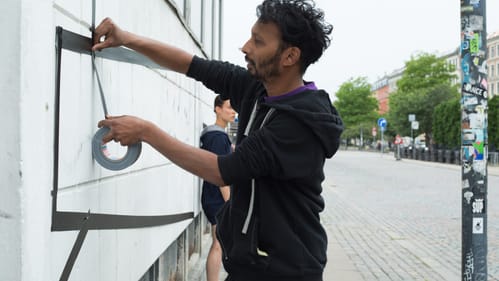Stay in the Loop
BSR publishes on a weekly schedule, with an email newsletter every Wednesday and Thursday morning. There’s no paywall, and subscribing is always free.
Meditations on the city
PIFA 2018: Asphalt Piloten's 'Tape Riot'

Tape Riot, by performance group Asphalt Piloten, has been performed almost 100 times across Europe, Asia, and the Americas. It’s part performance art and part dance, intended — according to its creator, Swiss choreographer Anna Anderegg — to allow city dwellers to look at their urban landscape through new eyes. PIFA 2018 offers a rare U.S. performance in Center City.
There’s a heightened atmosphere at the secret meeting spot, given to ticket buyers by email just before the show. Members of an unusual congregation size each other up, wondering who is here for the show and who is just a regular citizen. There are also more photographers and journalists than performers, all training their cameras on what must look like a random intersection to passersby.
"Is this real?"
Even before the performance begins, it achieves Anderegg’s goal. Her artist’s statement says, “It merely causes the onlookers' gaze to shift slightly, prompting silent curiosity: Is this normal? Is this real?”
Anders Ehlin, billed as the urban composer, carries an iPad and two speakers on his hips like panniers. He creates a repetitive, apocalyptic soundscape in real time, and the crowd turns like a flock of nervous birds, craning to see where something unusual, as anticipated, is happening.
Dancers Laura Keil and Adaya Berkovich do not so much enter the space as become visible. They seem to have been there all along, and it takes a moment to distinguish them from the crowd. Keil and Berkovich drape themselves over elements of the landscape like lions, with a balance of tension and perfect ease.
They move among the spectators with the confident indifference of creatures in their native environment. Their movements are weighted; these are not bodies working against nature but with it. The result is like being on safari.
Mindfulness as art
Much like the dancers, tape-art creations by Hervé Thiot seem to appear suddenly. Thiot works with the same unencumbered naturalism as the dancers. He seems to be revealing images that already exist within the streets and walls. Thin lines of masking tape become doors to places we feel must always have been hovering just behind a brick wall. It really is magical.
Participating in Tape Riot as a spectator is a meditation. The piece pulls focus toward the city we habitually ignore. At first, the heightened attention is thrilling, as is the series of events happening in the performance. A brick is as interesting as a dance step is as interesting as a pair of baffled teenagers looking on.
For most of the performance, that focus is maintained by the desire to make sense of what’s happening and to create a story from it. There isn’t one, though. Tape Riot doesn’t offer an arc or commentary; it uncovers the elements of meaning-making just enough to keep our wandering minds on the world as it is for a moment.

The show offers a reprieve from the demands of dwelling in a city. Or, as Anderegg says, “the strange sensation of having seen the urban space quite differently and with a smile.”
The city interacts back
It’s amusing to watch 15 people, with all manner of recording devices, document three apparently indifferent performers, and equally so to regard the way the performance moves among people. As 10 audience members stood transfixed in the bike lane, they were inevitably shouted down by commuter cyclists, a rude interruption that was undeniably appropriate.
The procession repeatedly crossed into traffic or rerouted cars, using not permits but general bafflement to keep the danger at bay. There’s a power in behaving as though art comes first, which is part of what Tape Riot offers.
That behavior, however, is surely a very different experience in an upscale Center City neighborhood than it would be anywhere else in the city. This iteration of Tape Riot was a stroll through some very well-kept and expensive real estate. That doesn’t totally jibe with its intention of engaging with urban landscapes, but it does create fun opportunities to watch property owners respond to a pack of hooligan dancers sticking masking tape on their garages.
Mindfulness has a shelf life, and it comes about 30 minutes into this 45-minute performance. Focused attention gives way to an opportunity to notice how focused attention is lost. We feel a responsibility to the performance and to the altered perspective it offers, but as Tape Riot refuses to resolve into a story or a clear message, this becomes harder to do.
That’s not a criticism of the performance. Ultimately, Tape Riot is not an exploration of the city but of the viewer’s experience. It’s public, but it’s also personal and reflective, which makes it a rare and valuable chance to step out of the usual by stepping into it.
What, When, Where
Tape Riot. By Anna Anderegg and Asphalt Piloten. Through June 8, 2018, at various locations throughout Center City. Ticketholders will receive an email with the location before their performance. (215) 893-1999 or pifa.org.
Sign up for our newsletter
All of the week's new articles, all in one place. Sign up for the free weekly BSR newsletters, and don't miss a conversation.

 Cara Blouin
Cara Blouin